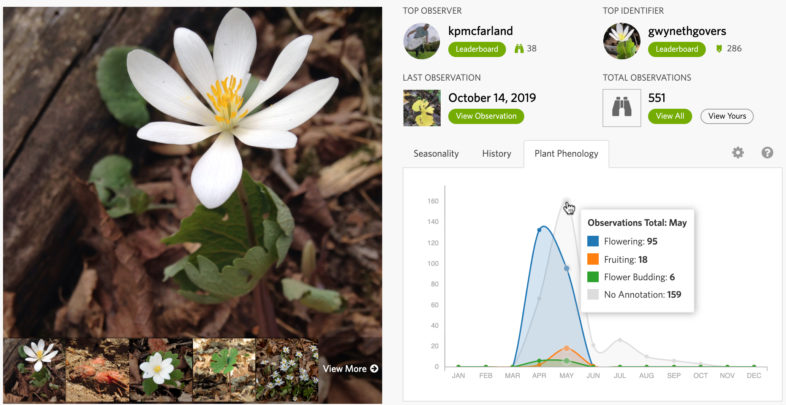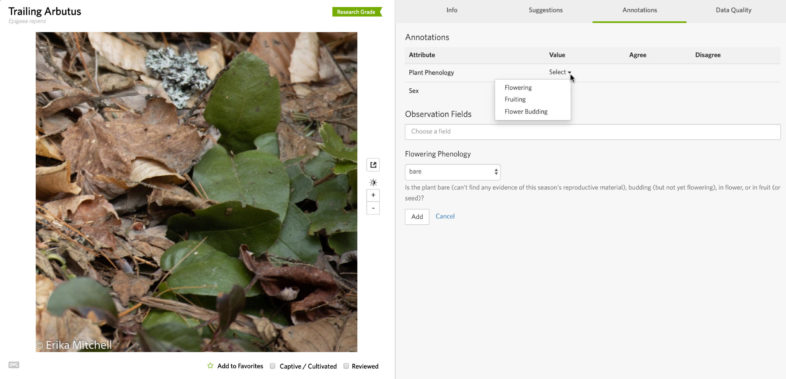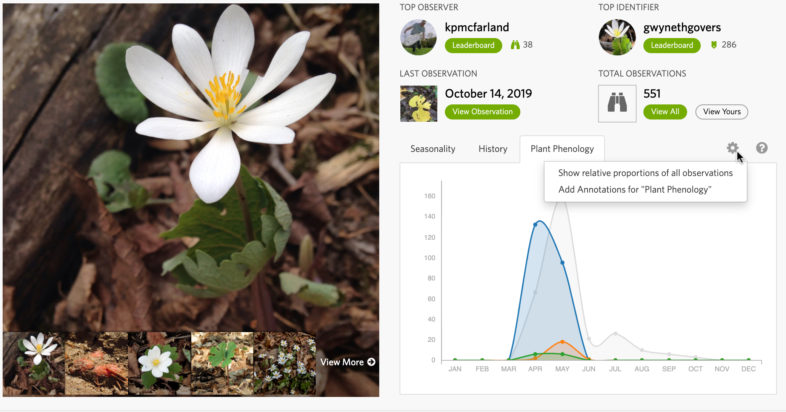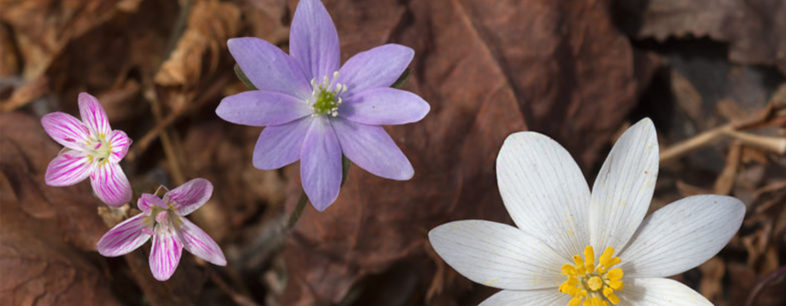
Vermont Bloodroot flowering phenology for iNaturalist annotated data. There are several hundred observations that are not annotated! Help us add important data. (click on image to see this at iNaturalist).
Long-term flowering records initiated by Henry David Thoreau in 1852 have been used in Massachusetts to monitor phenological changes. Phenology—the study of the timing of natural events such as migration, flowering, leaf-out, or breeding—is key to examine and unravel the effects of climate change on ecosystems. Record-breaking spring temperatures in 2010 and 2012 resulted in the earliest flowering times in recorded history for dozens of spring-flowering plants of the eastern United States.
You can be like Thoreau right from home! There are thousands of images of plants that observers like you have added to the Vermont Atlas of Life on iNaturalist. But, they have not been annotated so that we can easily track phenology.
Please log in and help us add this valuable information. It’s easy and fun! All you have to do is look at beautiful images of plants and note whether they have flower buds, flowers, or fruits. And, thanks to bouteloua on iNaturalist for the brilliant idea!
Box Score (4/3/2020)
- March – July “spring wildflower” observations unannotated: 5,965
- All flowering plant observations unannotated: 87,994
- All flowering plant observations annotated: 35,047
Join the Flower Phenology Annotation Blitz
- Go to iNaturalist.org and sign in or create an account.
- Click on this link to go to the Identify page on iNaturalist. Use this link so that the filters are set for you to start your work on spring wildflowers – https://www.inaturalist.org/observations/identify?reviewed=any&quality_grade=needs_id%2Cresearch&list_id=111820&month=3%2C4%2C5%2C6%2C7&without_term_id=12
or you can go big and work on all flowering plants-
https://www.inaturalist.org/observations/identify?reviewed=any&quality_grade=needs_id%2Cresearch&without_term_id=12&taxon_id=47125 - Click on one of the cards to expand it in a new box.
- Select the Annotations tab at the top of the page. Examine the image(s) carefully and see if there are any flowers budding, flowers, or fruiting. If you see any of those, select one of those for Plant Phenology. If there is more than one stage on a single plant, another Plant Phenology will appear and you can select another stage for the same observation.
- What if it is bare? If there are no stage of flowering or fruiting, under Observations Fields, type in Flower Phenology and select it from the list. Then add “bare” and click Add. See the example below.
7. You can use keyboard shortcuts to make annotation go more quickly!
p then u to mark it as flowers budding
p then l to mark it as flowering
p then r to mark it as fruiting
Wait a moment for it to save, then press → (right arrow key) to move on to the next observation.
8. Would you like to see other tutorials to help you understand it better? Here’s another tutorial and longer page about annotations, but also feel free to drop questions via iNaturalist to me or our intrepid Vermont Atlas of Life outreach person, Emily Anderson.
Do You Have a Favorite Plant You’d Like to Annotate?
You can do all the annotations for your favorite plants at once too. Just go to the Identify page with this link (sets location and observations lacking annotations for you in the filter) – https://www.inaturalist.org/observations/identify?reviewed=any&quality_grade=needs_id%2Cresearch&without_term_id=12 and put the plant name in the species box, select the species in the dropdown that appears, and click go. Start annotating!
Or visit a species account, like bloodroot for example below, and after you learn more about the plant on the page, click the little gear icon and select ‘Add Annotations for Plant Phenology’.
Add Your Own Observations too!
And don’t forget, you can add new observations and annotate them yourself! While observing “social distancing” and staying close to home, find a nearby area to monitor or simply record the status of plants you find.
Perhaps were he alive today, Henry David Thoreau would be surprised at how many of us are watching and recording flower phenology!
Some Fabulous Spring Wildflowers to Discover and Observe
(click to see field guide at the Vermont Atlas of Life on iNaturalist):
Trout Lily (Erythronium americanum)
Bloodroot (Sanguinaria canadensis)
Marsh Marigold (Caltha palustris)
Carolina Spring Beauty (Claytonia caroliniana)
Red Trillium (Trillium erectum)
Painted Trillium (Trillium undulatum)
Starflower (Trientalis borealis)
Dutchman’s Breeches (Dicentra cucullaria)
Squirrel Corn (Dicentra canadensis)
Jack-in-the-pulpit (Arisaema triphyllum)
Canada Violet (Viola canadensis)
Wild Ginger (Asarum canadense)
Sharp-lobed Hepatica (Anemone acutiloba)
Early Blue Cohosh (Caulophyllum giganteum) and Blue Cohosh (Caulophyllum thalictroides)



